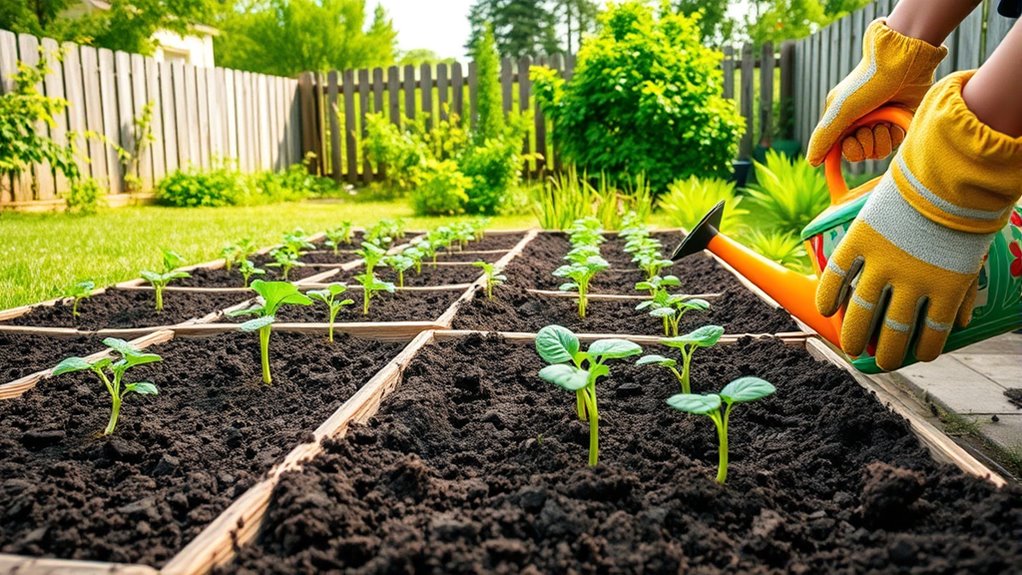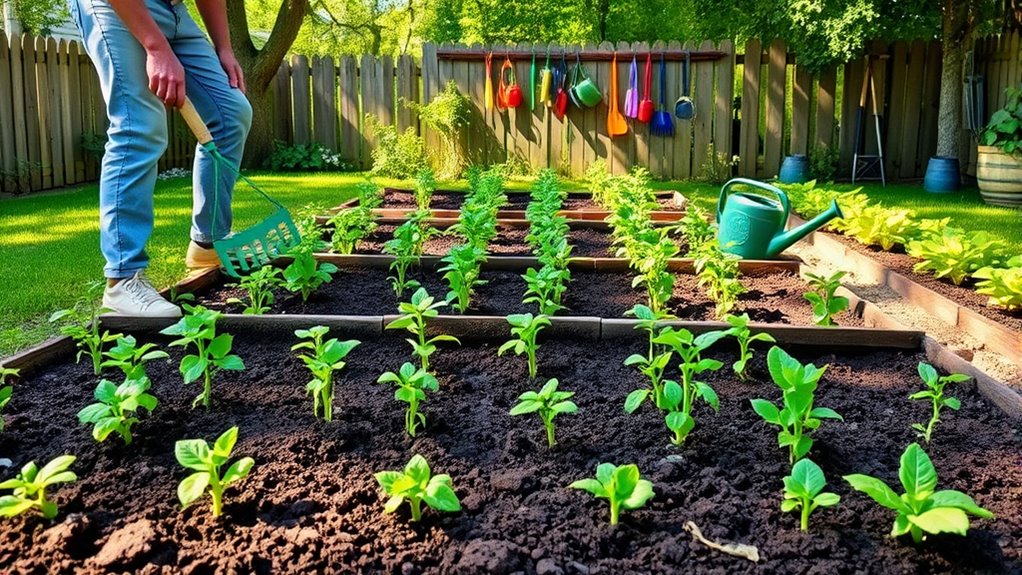To start a vegetable garden in your backyard, begin by choosing a sunny spot with at least six hours of direct sunlight daily. Test your soil and amend it with compost or organic matter for better nutrients and drainage. Plan your layout using companion planting to repel pests and boost growth. Clear weeds, loosen the soil, and plant healthy seedlings or seeds, then maintain your garden with watering, mulching, and pest monitoring. Keep exploring for more tips to guarantee a successful harvest.
Key Takeaways
- Choose a suitable sunny location with well-draining soil for your vegetable garden.
- Test and amend soil to ensure proper pH and nutrient levels before planting.
- Plan your layout with crop rotation and companion planting to maximize space and health.
- Prepare the site by clearing debris, loosening soil, and adding organic matter.
- Maintain your garden with regular watering, mulching, pest monitoring, and soil health checks.

Starting a vegetable garden is a rewarding way to enjoy fresh produce and connect with nature. Before you dig in, it’s important to plan carefully to guarantee your garden thrives. One of the best ways to do this is by understanding companion planting, which involves pairing certain plants together to improve growth, deter pests, and maximize space. For example, planting basil near tomatoes can enhance flavor and repel insects, while carrots and onions grown side by side can help keep pests away from each other. By choosing compatible plants, you’ll create a healthier, more productive garden without relying heavily on chemicals.
Companion planting boosts garden health, flavor, and pest resistance naturally.
Before planting, you should also perform soil testing. This step is vital because it tells you about your soil’s pH level and nutrient content. With this information, you can amend the soil as needed, adding organic matter, lime, or fertilizer to create an ideal environment for your vegetables. Soil testing kits are affordable and simple to use; just collect a sample, send it to a lab or use a home-testing kit, and review the results. Knowing your soil’s condition helps you avoid common issues like poor drainage or nutrient deficiencies, which can stunt your plants’ growth. Additionally, understanding your soil’s nutrient profile can help you select the right vegetarian protein sources for your diet if you are interested in plant-based eating.
Once you have your garden layout planned, including companion plantings, and your soil has been tested and amended, it’s time to prepare the space. Clear out any weeds, rocks, or debris, and loosen the soil with a garden fork or tiller. Incorporate compost or organic matter to improve soil structure and fertility. When planting, pay attention to the sun exposure your yard offers. Most vegetables need at least six hours of direct sunlight daily, so choose a spot that gets ample light and is protected from harsh winds.
As you plant, consider crop rotation and succession planting to keep your soil healthy and your garden productive throughout the season. Rotate families of plants each year to prevent soil-borne diseases and nutrient depletion. You can also plan for succession planting by sowing new seeds or transplanting seedlings as soon as space opens up, ensuring a continuous harvest.
Throughout the growing season, monitor your plants regularly for signs of pests or disease. Use companion planting as a natural pest control method, and keep your soil healthy through continued testing and amendments. Water your garden consistently, aiming for deep, infrequent watering to encourage strong root development. Mulching helps retain moisture, suppress weeds, and keep the soil temperature steady. With patience and attention, your garden will flourish, providing you with fresh vegetables and a sense of accomplishment in nurturing your own food.
Frequently Asked Questions
What Is the Best Time of Year to Plant Vegetables?
You should plant vegetables during the right seasonal planting time for your climate, which varies based on your location. Generally, spring is ideal for many crops, but some vegetables thrive in summer or fall. Consider your local frost dates and seasonal changes to plan accordingly. Adapt for climate considerations, such as shorter growing seasons or milder winters, to guarantee your vegetables have the best chance to grow successfully.
How Do I Prevent Pests From Damaging My Garden?
Pests can be like uninvited guests wrecking your garden party. To keep them at bay, try companion planting—pairing plants that naturally repel pests with your vegetables. Use natural pest control methods, like introducing beneficial insects or spraying neem oil. These strategies create a balanced ecosystem, making pests think twice before attacking. Stay vigilant, and your garden will thrive without harmful chemicals, turning it into a pest-free paradise.
What Soil Amendments Improve Vegetable Growth?
To improve vegetable growth, you should focus on soil amendments like compost addition and pH adjustment. Adding compost enriches your soil with nutrients and improves its structure, promoting healthy roots. If your soil’s pH isn’t ideal, use lime to raise it or sulfur to lower it, ensuring plants can absorb nutrients efficiently. Regularly testing your soil helps you fine-tune these amendments, giving your vegetables the best chance to thrive.
How Often Should I Water My Garden?
You should establish a consistent watering schedule, typically watering your garden deeply 1-2 inches weekly, adjusting for rain and soil moisture. During drought management, increase watering frequency to prevent stressed plants, but avoid overwatering. Keep an eye on plant signs like wilting or yellowing leaves, and water early in the morning or late in the afternoon to minimize evaporation. Proper watering helps your garden thrive, even during dry spells.
Can I Grow Vegetables in Containers Instead of the Ground?
Like planting seeds of hope, you can definitely grow vegetables in containers instead of the ground. Urban gardening thrives with container varieties, making it perfect for small spaces or balconies. You just need sturdy pots with drainage, quality soil, and the right vegetables suited for containers. With a little care, you’ll enjoy fresh produce and the satisfaction of turning limited space into your personal vegetable patch.
Conclusion
Now that you’ve taken the first step, your backyard is no longer just a patch of dirt—it’s a promise of fresh, homegrown produce. With a little patience and care, you’ll soon witness your garden flourish in ways you never imagined. But remember, the true magic begins when you least expect it. Keep tending, stay curious, and watch as your efforts transform not just your yard, but your entire outlook on nature’s surprises. The best is yet to come.








